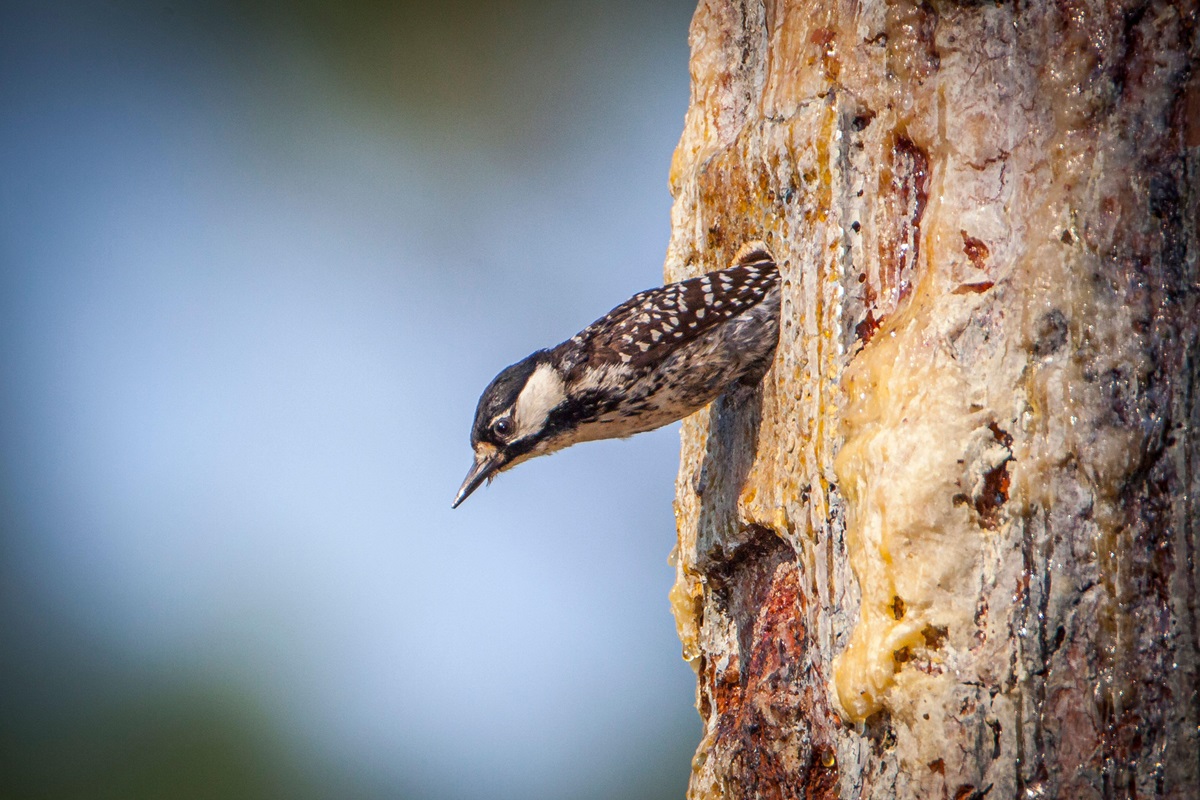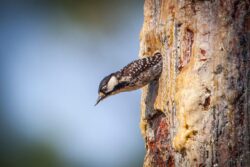The Long Game
Longleaf pine restoration contends with arson in Vernon Parish
Published: February 29, 2024
Last Updated: October 17, 2024

Photo by Danita Delimont, Alamy Stock Photo
A red-cockaded woodpecker.
Two centuries ago, longleaf pine commanded the landscape of the southeastern United States. The trees have largely been chewed up into lumber; the US Forest Service estimates a 97 percent decline of these trees in the ecosystem since the arrival of European colonists. I grew up walking on longleaf, the polished floorboards of my parents’ circa 1914 home in Lake Charles’s Charpentier District. I didn’t see much of it out my window.
DeGravelles, a land steward and restoration ecologist for the Nature Conservancy in Louisiana, leads just one of innumerable, allied efforts to restore longleaf pine to the nine-state historic range from which it was eagerly harvested and milled but rarely replanted, with the faster-growing loblolly and slash pines favored instead.
In 2013 the Nature Conservancy, with help from the federal government, purchased a tract of industrial timberland near Fort Johnson, formerly Fort Polk. The 850 acres are surrounded on three sides by the Kisatchie National Forest and, in the Conservancy’s hands, created a needed buffer for military training activities.
“The military actually has some of the finest longleaf pine in the west Gulf coastal plain on their base in Fort Johnson,” said DeGravelles. “That’s both on purpose—they do prescribed burning—but they also incidentally start fires when they shoot artillery. Those regular fires are actually a really good thing. Historically, about two-thirds of Louisiana was a fire-maintained system in one form or another, meaning lightning-derived fire or fire derived from the activities of Indigenous people. The fires happened routinely, every two to three years. They shaped the ecosystems that occurred here over millennia, thus many different species are not just adapted to fire but require it.”
One such species plays an outsized role in the current restoration effort. The red-cockaded woodpecker is the only woodpecker in North America that builds cavities in live pine trees. Small groups of birds work together, and one cavity can take years. The bird requires old, mature pines and regularly fire-maintained woodland. It avoids a dense forest like the thicket of loblolly pines currently on the tract, instead seeking open woodland with lots of ground cover: thick, warm-season grasses and herbs and not much brush.
Because of the woodpecker’s status as a federally endangered species, the military is obliged to help with protective steps. “The military and the Forest Service are managing very strongly for the red-cockaded woodpecker,” said DeGravelles, “both by using prescribed fires and creating artificial cavities in the trees.”
The process of thinning out the loblollies on the tract had only begun in the past couple of years, with a goal of reducing total wood density by roughly half. But DeGravelles explained, “We hadn’t yet done much work because when we acquired the land, these loblolly pines were really young. They have to achieve a certain size to be merchantable,” or marketable. The drought had delayed plans for a prescribed burn. “Weather is everything in fire,” said DeGravelles. Louisiana requires Certified Prescribed Burners to have a burn plan, which includes weather conditions the burner will adhere to—for example, wind direction to account for smoke, as well as a contingency plan should the fire escape the burner’s fire lines.
So the fires that consumed the area last summer were not prescribed—but the rogue burner had the effect of killing off many of the loblolly pine trees that would have been removed by the Nature Conservancy anyway. The wildfire took its mightiest course through the sections that were unthinned, with copious pine needles on the ground adding potency.
While waiting out the end of last summer’s long drought to see the true extent of wildfire damage, DeGravelles and his colleagues developed a strategy for the eventual restoration. Some of the charred trees can become pulp wood, if they’re large enough and harvested quickly. The unsalvageable dead trees will rot away in a few years, which avoids the expense and disturbance to the soil that the involvement of machinery would bring. “We’ll have to do it in a different way than we had planned,” said DeGravelles. “We planned to do it in phases, but we’ll just have to come in and plant young longleaf right from the start. We’ll clear cut all the loblolly on the tract, plant the young leaf, and start with a big, open young pool.”
. . . the fires that consumed the area last summer were not prescribed—but the rogue burner had the effect of killing off many of the loblolly pine trees that would have been removed by the Nature Conservancy anyway.
Longleaf resembles a big sprig of grass when it first germinates and can remain in that stage up to ten years as it puts a deep taproot into the soil. “Once it starts growing, it grows fast,” said DeGravelles. Fire stimulates the move out of the grass stage. “But early foresters didn’t understand that.” For much of the twentieth century, DeGravelles explained, fire was considered to be “universally evil.”
Understood and used well, fire can open up the land for species such as the red-cockaded woodpecker or the pine snake or the migrating grassland birds whose population would diminish otherwise. Longleaf, as a tree and an ecosystem, is highly resilient. Compared to loblolly or slash pines, “it’s more fire tolerant, it’s more drought tolerant,” said DeGravelles. With efforts like longleaf restoration, the Nature Conservancy is working to protect not only the environments where endangered species currently dwell, but also the biodiverse sites that could house any number of species a hundred years from now—as well as the corridors along which species will migrate. “We call it conserving nature’s stage,” said DeGravelles.
I walked with DeGravelles through the tract, where the pine needles hadn’t yet fallen thickly enough to cover the singed ground, negotiating around dead loblollies and the aggressive, invasive growth of French mulberry and yaupon trees in the understory. We’re all interlopers in these centuries of change. When I come back next, my interloping won’t be so beset by twigs and ash, and the view will stretch out further until in some cavity, yards away, I see the scarlet tuft of a woodpecker.
64 Parishes welcomes Placemaking, a new environmental humanities column from contributor Lucie Monk Carter focused on humans and the natural world.
 Restore the Mississippi River Delta is a coalition of Environmental Defense Fund, National Audubon Society, the National Wildlife Federation, Coalition to Restore Coastal Louisiana, and Pontchartrain Conservancy. Together, we are working to rebuild coastal Louisiana’s nationally-significant landscape to protect people, wildlife and jobs.
Restore the Mississippi River Delta is a coalition of Environmental Defense Fund, National Audubon Society, the National Wildlife Federation, Coalition to Restore Coastal Louisiana, and Pontchartrain Conservancy. Together, we are working to rebuild coastal Louisiana’s nationally-significant landscape to protect people, wildlife and jobs.
